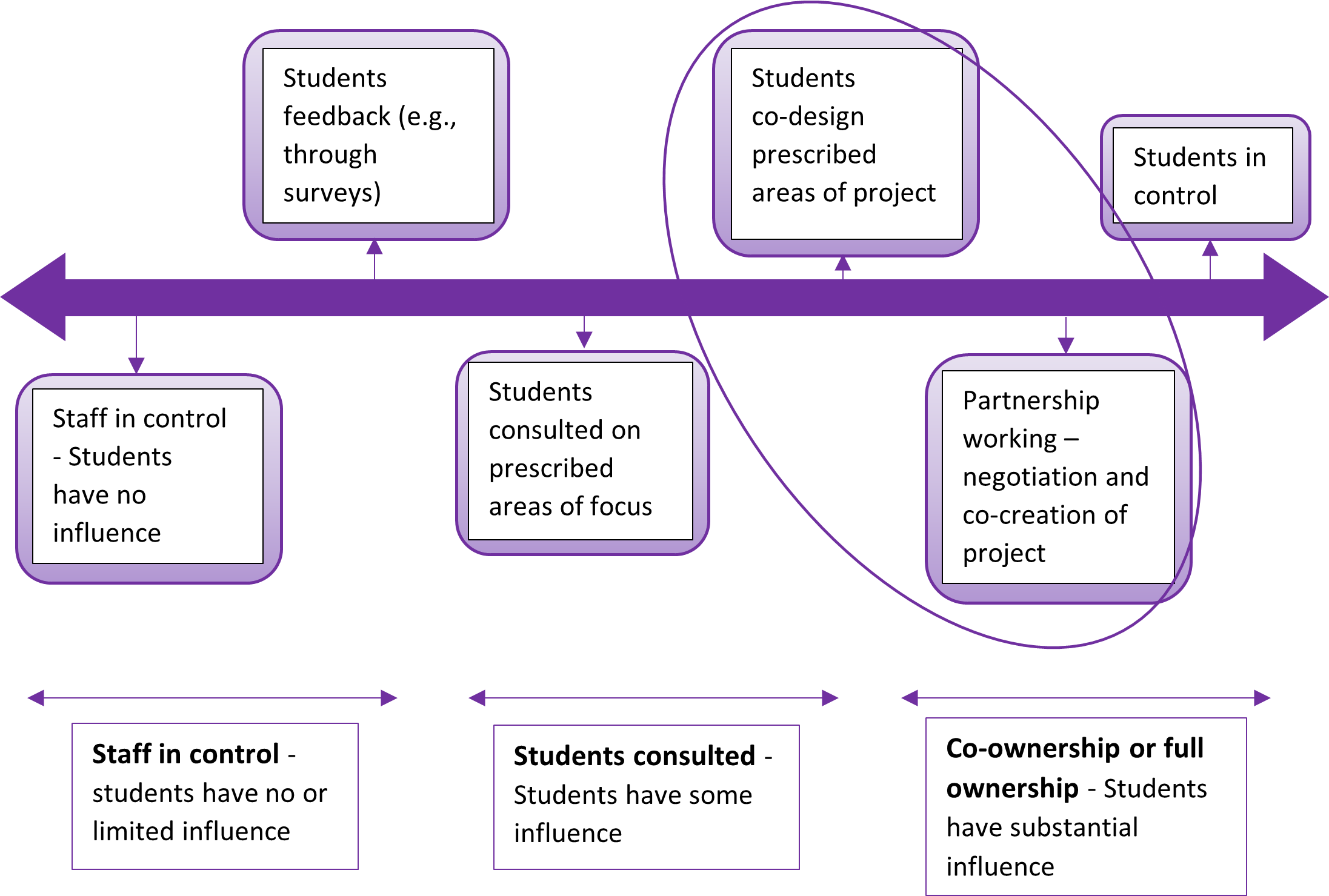Introduction
Working with students to co-create, co-teach, co-research and co-develop their educational experiences has become an increasingly common practice in higher education across the globe. The University requires colleagues to work with students in course enhancement and approval processes (see 1.9b of the course approval form and both the minor and major course modification forms).
Working with students as partners on educational development projects enables a more contextualised understanding of complex experiences students face and directly involves those affected by initiatives in shaping them, which is more likely to result in sustainable change. However, this is not the only way to work with students as partners, and this guide will explore some of the various ways this could be undertaken.
Student partnership work differs from other student voice mechanisms, insofar as the former seeks to work with students in a collaborative and reciprocal process to make change together through pedagogical or curricula decision-making, investigation, evaluation and implementation. A visual way of understanding this move from students in a consultative role (point 3 on the scale below) - often in roles such as academic course representatives - into partnership work can be seen in the diagram below (inspired by a range of existing partnership models: Bovill & Bulley, 2011; Varwell, 2021; Healey et al., 2014). Working with students as partners is a shift towards points 4 and 5 on the below spectrum of working with students to develop their education.

The aim of this guidance is not to suggest a one-size-fits-all approach to working in partnership with students, but rather to offer some ways of thinking about the type of partnership you might like to undertake, and to support you in how to begin. This guidance has been written to provide examples of approaches both within the collegiate University and across the wider sector, highlighting some key aspects to consider and practical steps to undertake before working with students as partners.
The term 'students as partners' conjures up different assumptions and practices for different people, but as an umbrella term it is employed to capture the nature of working directly with students in an approach that recognises and appreciates their own expertise (Cook-Sather et al., 2018). Other phrasing to describe such activities include co-creation, co-producers, student change agents.
Working in partnership with students is not to say that students are in control of all decision-making, nor that staff expertise is not recognised, but that it values the differing contributions of both staff and students equally. Working with students in this approach offers a counter0narrative to the prevailing discourse surrounding higher education that students are consumers and passive recipients of education (Wenstone, 2013). This is a transactional approach to higher education, and it limits the extent to which students can shape their experiences. It also, in turn, places staff working behind the curve of issues students are facing. Working with students in partnership, in contrast, "makes way for respectful, mutually beneficial learning partnerships where students and staff work together on all aspects of educational endeavours" (Matthews, 2017:1).
What is important at the start of any partnership project is to set clear boundaries and expectations and to be clear on the values on which the partnership model is built. Mercer-Mapstone and Marie summarise student-staff partnership values as being founded on:
A way of thinking that positions students as partners, experts and colleagues in - rather than evaluators of - teaching and learning.
A way of engaging where teaching and learning is something that is done with, rather than done to, students.
A way of working that nourishes partnerships based on respect, reciprocity and shared responsibility.
(Mercer-Mapstone & Marie, 2019: 7)
Through this framing of partnership working, the nature and focus of the project can be built on mutual respect and equal valuing of each member's particular expertise in different areas. This forms a foundation on which to build successful student-staff partnership working.
This way of working can be differentiated to suit a range of contexts. You might be looking to undertake a discrete activity such as co-developing learning resources, or you might be looking to establish an annual cycle of students-as-partners activities and projects. Such projects can be focused on pedagogical development, supporting research, or targeted development opportunities within the College or University experience. Partnership work can involve working with an individual, groups of students or a larger-scale initiative involving a whole cohort. Students may be selected, elected or recruited for the role, and the nature of the endeavour and the context will shape what is most appropriate.
You might seek to explore any number of areas within the student experience, such as assessment, feedback, student engagement, teaching resources, curriculum design or pastoral support. There are multiple methods to work with students as partners and your context and the type of work you would like to undertake will guide the approach you take. A useful starting point to help you decide this might be to explore Bovill's typology model outlined in her article 'A co-creation of learning and teaching typology: What kind of co-creation are you planning or doing?' (Bovill, 2019).
